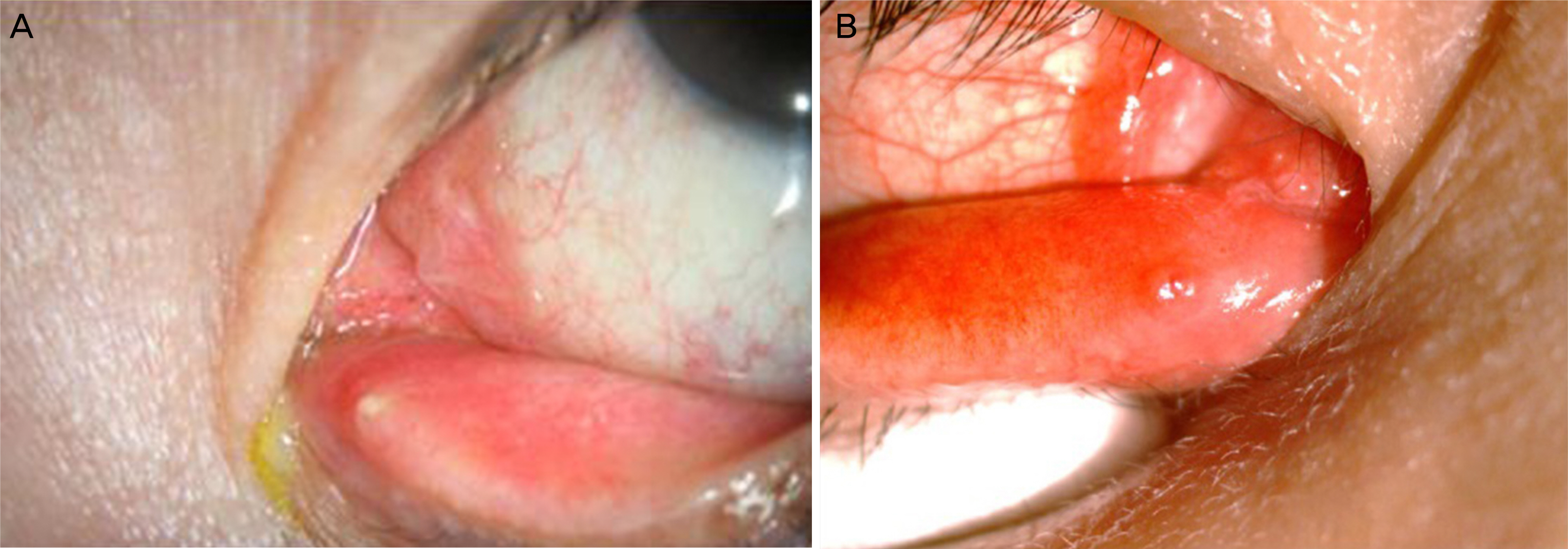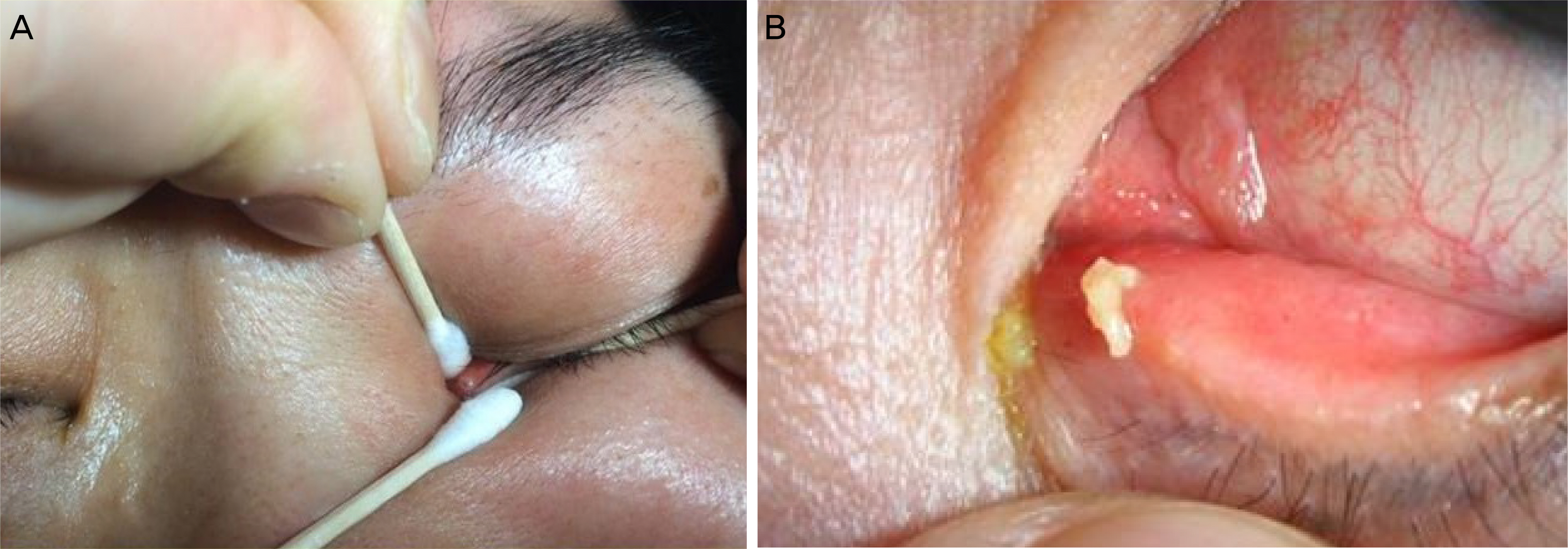J Korean Ophthalmol Soc.
2016 May;57(5):700-704. 10.3341/jkos.2016.57.5.700.
Therapeutic Effect of Squeezing the Punctum and Lacrimal Canaliculus in Canaliculitis Patients
- Affiliations
-
- 1Department of Ophthalmology, Korea University College of Medicine, Seoul, Korea. shbaek6534@korea.ac.kr
- 2Department of Ophthalmology, Cheonan Chungmu Hospital, Cheonan, Korea.
- KMID: 2212710
- DOI: http://doi.org/10.3341/jkos.2016.57.5.700
Abstract
- PURPOSE
To report the therapeutic effect of squeezing the punctum and lacrimal canaliculus using Q-tips in canaliculitis patients.
METHODS
From March 2004 to February 2014, 42 eyes of 42 patients diagnosed with canaliculitis at our clinic were retrospectively analyzed. To remove the discharge and concretions, the punctum and lacrimal canaliculus were squeezed using Q-tips without invasive procedures.
RESULTS
The mean patient age was 56.39 years and mean follow-up period was 10.6 months. No statistical significance was observed in terms of rate of disease occurrence and mean age between males and females. Among the eyes analyzed, 30 (71.4%) were cured with only 1 squeezing procedure, 12 eyes (28.6%) required more than 2 procedures; 1 eye (2.3%) recurred and the period until recurrence was 3.8 months.
CONCLUSIONS
Most studies support surgical management as the definitive therapy for canaliculitis to remove concretions that serve as a reservoir for bacteria. The gold standard treatments are curettage or canaliculotomy; however, these are not safe procedures and may result in epiphora in post-procedure patients due to the risk of lacrimal pump dysfunctioning or scarring of the canalicular system following invasive procedure. Squeezing punctum and lacrimal canaliculus only using Q-tips is effective in removing the canalicular concretions and without causing complications in the canalicular system.
Keyword
MeSH Terms
Figure
Reference
-
References
1. Anand S. Hollingworth K. Kumar V. Sandramoull S. Canaliculitls: the incidence of long-term epiphora following canaliculotomy. Orbit. 2004; 23:19–26.2. Lin SC. Kao SC. Tsai CC, et al. Clinical characteristics and factors associated the outcome of lacrimal canaliculitis. Acta Ophthalmol. 2011; 89:759–63.
Article3. Tost F. Bruder R. Clemens S. Clinical diagnosis of chronic canaliculitis by 20-MHz ultrasound. Ophthalmologica. 2000; 214:433–6.
Article4. Perumal B. Meyer DR. Vertical canaliculotomy with retrograde expression of concretions for the treatment of canaliculitis. Ophthal Plast Reconstr Surg. 2015; 31:119–21.
Article5. Buttanri IB. Serin D. Akbaba M. Karslioglu S. Incision-sparing management of canaliculitis. Orbit. 2014; 33:356–8.
Article6. Fulmer NL. Neal JG. Bussard GM. Edlich RF. Lacrimal canaliculitis. Am J Emerg Med. 1999; 17:385–6.
Article7. Zaveri J. Cohen AJ. Lacrimal canaliculitis. Saudi J Ophthalmol. 2014; 28:3–5.
Article8. Lee MJ. Choung HK. Kim NJ. Khwarg SI. One-snip punctoplasty and canalicular curettage through the punctum: a minimally invasive surgical procedure for primary canaliculitis. Ophthalmology. 2009; 116:2027–30. e2.9. Hill RH 3rd. Norton SW. Bersani TA. Prevalence of canaliculitis requiring removal of SmartPlugs. Ophthal Plast Reconstr Surg. 2009; 25:437–9.
Article10. Freedman JR. Markert MS. Cohen AJ. Primary and secondary lacrimal canaliculitis: a review of literature. Surv Ophthalmol. 2011; 56:336–47.
Article11. Kaliki S. Ali MJ. Honavar SG, et al. Primary canaliculitis: clinical features, microbiological profile, and management outcome. Ophthal Plast Reconstr Surg. 2012; 28:355–60.12. Zaldívar RA. Bradley EA. Primary canaliculitis. Ophthal Plast Reconstr Surg. 2009; 25:481–4.
Article13. Khu J. Mancini R. Punctum-sparing canaliculotomy for the treatment of canaliculitis. Ophthal Plast Reconstr Surg. 2012; 28:63–5.
Article14. Jin X. Zhao Y. Tong N. Xu W. Use of crawford tube for chronic suppurative lacrimal canaliculitis. Ophthal Plast Reconstr Surg. 2014; 30:229–32.
Article15. Gogandy M. Al-Sheikh O. Chaudhry I. Clinical features and bacteriology of lacrimal canaliculitis in patients presenting to a tertiary eye care center in the Middle East. Saudi J Ophthalmol. 2014; 28:31–5.
Article



